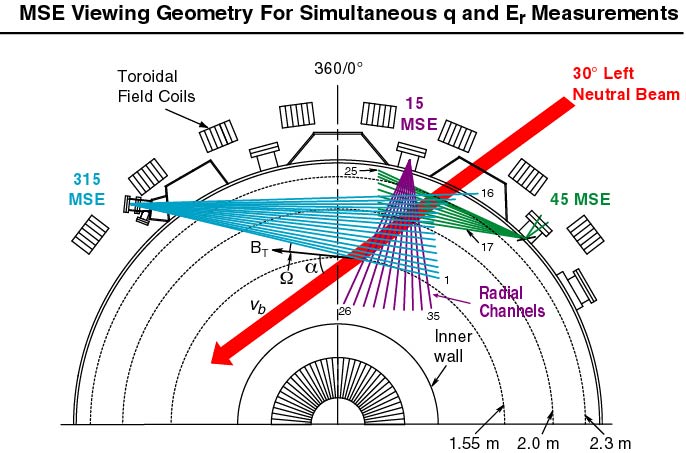
Ports List | Back | Foward
MSE, CER
15 R-0
Motional Stark Effect (MSE) Diagnostic
The main purpose of MSE is to measure the profile of the magnetic field pitch angle (or equivalently the current density profile) in tokamak plasmas. In conjunction with the equilibrium code EFIT, this information allows the safety factor, q,to be determined which is important for the understanding of both stability and confinement in tokamaks. The MSE system can also provide information on the profile of the radial electric field, Er.
The MSE technique relies upon the Stark splitting of the Balmer alpha line emitted from high-energy neutral hydrogen (or deuterium) atoms injected into the plasma. The neutral atoms experience a large Lorentz electric field E=v x B due to their motion across the plasma magnetic field. The strong electric field causes a splitting of the alpha emission into 9 distinct lines with two polarization states, π and σ. The π and σ states are polarized parallel and perpendicular to the electric field respectively. By measuring the polarization angle of the light emission, and knowing the beam injection velocity vector, v, one can then deduce the pitch angle of the magnetic field.
The MSE diagnostic is sensitive to the background electric field in the plasma as well as the motional v x B field of the high-energy beam atoms. In most plasmas with lower pressure gradients and rotation velocities, the v x B field is much larger than the plasma Er, so Er can be neglected.

Charge Exchange Recombination
The Charge Exchange Recombination (CER) Spectroscopy system is used to measure ion temperature, poloidal and toroidal rotation speed, impurity density. These are determined from the Doppler broadening, Doppler shift, and total intensity of the spectroscopic line. In addition, by using the radial force balance equation, the radial electric field in the plasma can be determined from these other quantities.
The desired signal for the spectroscopic measurement is produced by charge exchange between neutrals in the neutral beams and ions in the plasma. Typically, we use lines radiated by charge exchange with fully stripped ions of low Z impurities (e.g. carbon, boron), since they exist everywhere in the discharge. The measurement is spatially localized at the point where the viewchord crosses the neutral beam. The system can measure spectral lines in the wavelength range from 300 nm to 800 nm; the best sensitivity is in the visible and near IR from 400 to 800 nm.